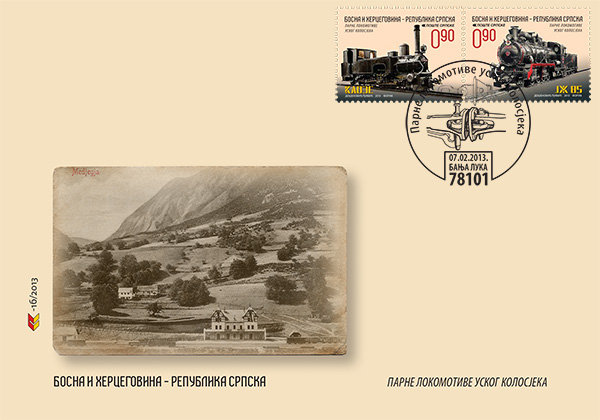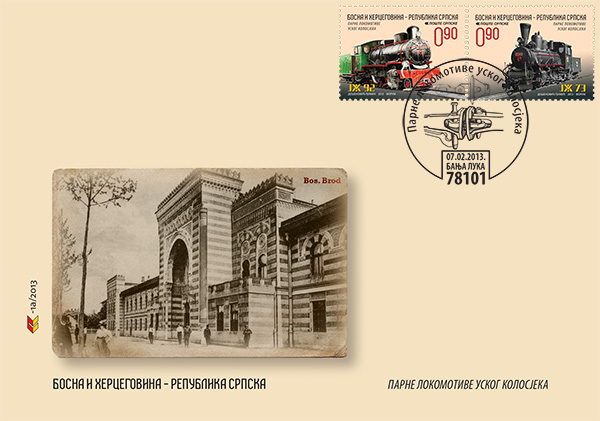Narrow gauge steam locomotives
Title::Narrow gauge steam locomotives
Date of Issue:07.02.2013
Author:Djumic/Dosenovic
Type edition:commemorative
Printing techniques:multicolour offset
Sheet:8+1
Paper:muflep 100g
Printing House:Forum, Novi Sad
 Motive:locomotive KLOZE
Motive:locomotive KLOZE
Catalogue no.:589
Perforation:13 3/4
Face value:0,90 BAM
Quantity:15 000
 Motive:locomotive JZ 92
Motive:locomotive JZ 92
Catalogue no.:588
Perforation:13 3/4
Face value:0,90 BAM
Quantity:15 000
 Motive:locomotive JZ 85
Motive:locomotive JZ 85
Catalogue no.:587
Perforation:13 3/4
Face value:0,90 BAM
Quantity:15 000
 Motive:locomotive JZ 73
Motive:locomotive JZ 73
Catalogue no.:586
Perforation:13 3/4
Face value:0,90 BAM
Quantity:15 000

The system of narrow-gauge track in the territory of the Republic of Srpska (and Bosnia and Herzegovina) is enthroned, and - for the most part - built during the Austro-Hungarian monarchy since 1879. to 1916. In the Kingdom of Yugoslavia gauge railway infrastructure for 760 mm width is expanded and improved, and in the mid sixties - under the pretext of unprofitability and technological obsolescence - began planning its destruction. Latest 760 mm lines in the former Yugoslav republic of central abolished in May 1979, and the only surviving artifacts (formerly, the world wide monumental) narrow-gauge railway system today are the few steam locomotives, station buildings and bridges, which has long been away by the ravages of time ...
73 JZ SERIES
The first steam locomotive JZ 73 is supplied by factory "Kraus" in Linz 1907. In the period since 1907 to 1913 The State Railways of Bosnia and Herzegovina (BHStB) ordered a total of 23 machines of this type, which had a very appealing and modern design. JZ 73 series locomotives were three related and two free axle and two-axle tender. Two steam-cylinder developing 230 hp and have allowed these machines maximum speed of 50 km/h. They were used exclusively for hauling fast passenger trains on the plains and rails with a small rise, and its career has served on the lines Bosanski Brod-Sarajevo, Lasva-Travnik, Mostar-Konjic, Bosanski Brod-Teslic, Doboj-Simin Han and Prijedor-Sanica Gornja. Among railway personnel were favored for their simple and robust construction and high reliability and low maintenance costs. To date were saved three locomotives of this type: the Pozega 73-002, 73-018 in Jablanica and 73-019 in Frojahu (Austria).
92 JZ SERIES
In 1917 Austro-Hungarians from the German factory "Hensel" ordered the first 19 steam locomotives JZ 92. However, these huge machines have not arrived to the area of today's Republic of Srpska (Bosnia) until the beginning of the 1919, and already in 1922 "Hensel" in the name of the war reparations, to the Kingdom of SCS has delivered 30 locomotives of this type. According to surviving documents, a total of 25 machines JZ Series 92 to the end of World War II pulled the heavy and mixed freight trains on the main rail routes in this area, and after 1945 the majority of them had moved into eastern Serbia. This has been the second largest locomotive in the narrow stripes of Yugoslav Railways. They had four steam engines, two times three bound and one free shaft and Four-tender. Between the two world wars, and shortly after 1945 they worked on the railroad Bosanski Brod-Doboj-Zenica-Sarajevo and around Bosanski Brod, Mostar and Drvar. From 49 locomotives JZ 92 survived to this day only 92-043 machine, which is kept in the Railway Museum in Pozega.
Author: Nebojsa Djumic and МА Bozidar Dosenovic
Cooperation: Goran Barac, publicist from Banjaluka
Publisher: Poste Srpske ad Banjaluka

The system of narrow-gauge track in the territory of the Republic of Srpska (and Bosnia and Herzegovina) is enthroned, and - for the most part - built during the Austro-Hungarian monarchy since 1879. to 1916. In the Kingdom of Yugoslavia gauge railway infrastructure for 760 mm width is expanded and improved, and in the mid sixties - under the pretext of unprofitability and technological obsolescence - began planning its destruction. Latest 760 mm lines in the former Yugoslav republic of central abolished in May 1979, and the only surviving artifacts (formerly, the world wide monumental) narrow-gauge railway system today are the few steam locomotives, station buildings and bridges, which has long been away by the ravages of time ...
SERIES KLOSE
The first railway lines in the territory of the Republic of Srpska (Bosnia) were characterized by a very small radius of curvature, for which the first types of locomotives often jumped the rails. Innovative Swiss engineering solution of Adolf Klose in mind (so-called) "radial axis", allowed to tow and towed funds in the first narrow lines in this region pass through the afore mentioned sharp turns without any problems. In the period since 1885 to 1896 from the factory, "Kraus" in Linz at BH railroad locomotives arrived with 34 Klose radial oscillation, which proved to be a very strong and reliable towing machine. Due to the rapid growth of rail traffic on the lines of National Railways of Bosnia and Herzegovina (BHStB) until 1904 was ordered and delivered a total of 99 Klose`s machines, manufactured in five variants. Although hauled passenger and freight trains on almost all BH stripes, has not been saved non of this type of locomotive! After seven and a half decades of faithful service, the last Klose`s machines - 189-022 – was cut down on scrap metal in 1967.
85 JZ SERIES
A huge success, which narrow lines in this part of the Balkans made steam locomotive JZ 83, lead the Yugoslav state railways in 1930 and 1931 the factories of the Budapest "MAVAG" to order 35 locomotives JZ 85. In constructional terms, these machines were significantly enhanced by version of the JZ 83. They had four bound and two free shafts, two cylinders, which develops 420 horsepower and enabled a top speed of 50 km/h. In 1940, under license "MAVAG", in the factory of locomotive machines in Slavonski Brod, were made ten more machines of this type. Basically, hauled fast trains on the main railway routes: Belgrade-Sarajevo-Dubrovnik, Sarajevo-Vardiste-Visegrad, Sarajevo-Mostar-Bradina and Dubrovnik. Only two locomotive JZ 85 were saved: 85-045 in Uzice and 85-005, which is currently in the factory "Sinvoz" in Zrenjanin, where after the overhaul should be transferred to the "Sargan Eight".
Author: Nebojsa Djumic and МА Bozidar Dosenovic
Cooperation: Goran Barac, publicist from Banjaluka
Publisher: Poste Srpske ad Banjaluka
 1371
1371  kontakt@postesrpske.com
kontakt@postesrpske.com


